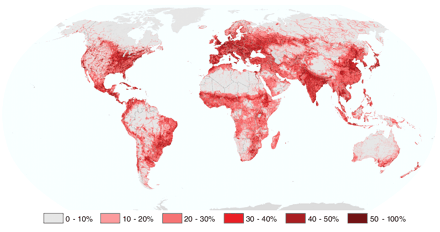Remember the recent post about ylang ylang? Timbuktu Chronicles sent me to an oldish article from South Africa’s Mail & Guardian which lists the tree among Madagascar’s fragrant exports. But the article is really about a rare and threatened Malagasy orchid and how it will be cultivated for the French perfume industry. I hope everyone has their ABS arrangements down tight.
Date tissue culture
Man has in vitro plan for Iraqi dates.
Millet beer froths up
A technological innovation revives traditional home brew in Uganda.
Absinthe explained
One of the more interesting uses of agricultural biodiversity.
Ecosystems services to the fore

The map shows human impact; the percentage of human influence relative to the maximum influence recorded for each biome. I got it from Resilience Science, which got it from Science magazine (where, I confess, I missed it). It deals with reshaping ecological processes on domesticated land. Anyway, rather than write my own version of the paper by Peter Karieva and his collaborators (which is behind a paywall), I point you straight to Resilience Science, noting in passing that I am certain I would not have done as good a job.